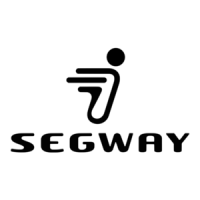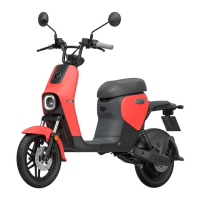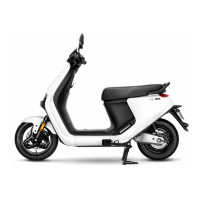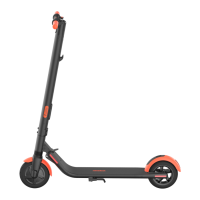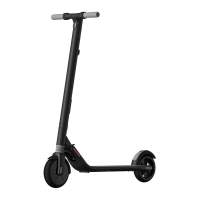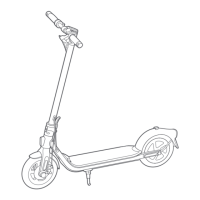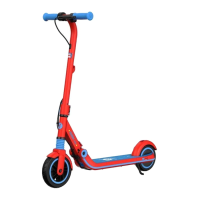may be affected by factors such as temperature, terrain and the rider.
Errors and failures Possible causes Solutions
Error code 11 Motor controller/battery Undervoltage Try charging the battery.
Error code 36 Weak signal in the ECU Please park the vehicle in an open space.
Error code 37 A low battery in the ECU
Leave the charged battery in the vehicle for more
than 5 hours.
Error code 41 The handlebar lock pin is not in place
Turn off the vehicle, turn the handlebar to fix the
jamming, and then restart.
Error code 10,12-30, 33-34, 38-40, 42 Vehicle abnormality
Please contact after-sales service or a designated
repair center.
The vehicle has no power
The battery connection is not in place
Please make sure the battery power plug
I connected properly.
Blown fuse Replace the fuse.
Short-range
Insufficient tire pressure
Check the tire pressure: front tire 26 psi
(180 kPa) and rear tire 32 psi (220 kPa).
Insufficient battery or charger failure Check the charger and fully charge the battery.
Frequent starts and stops, overloading
Maintain good riding habits and DO NOT
M
exceed the payload.
Battery failure
Please contact after-sales service or a designated
repair center.
Other failures
Issues that cannot be resolved by the user or
when the problem is unknown.
Smart service ( Airlock, SOS alert, OTA
upgrade, GPS positioning, auto vehicle
checkup, riding record, etc.) is not
available.
1. The smart service fee is not renewed or the
SIM card within the ECU has expired.
2. ECU failure
1. Renew the smart service fee in ‘After-sales
Service’ in the Segway-Ninebot App.
2. Change the ECU.
Certifications
This product complies with 16 CFR PART 1512:2019
The battery complies with UN/DOT 38.3.
The battery complies with ANSI/UL 2271.
Federal Communications Commission (FCC) Compliance Statement for USA
This device complies with part 15 of the FCC rules. Operation is subject to the following two conditions:
1. This device may not cause harmful interference, and (2) this device must accept any interference received, including interference that may cause
undesired operation.
NOTE
This equipment has been tested and found to comply with the limits for a Class B digital device, pursuant to part 15 of the FCC Rules. These limits are
designed to provide reasonable protection against harmful interference in a residential installation. This equipment generates, uses and can radiate radio
frequency energy and, if not installed and used in accordance with the instructions, may cause harmful interference to radio communications. However, there
is no guarantee that interference will not occur in a particular installation. If this equipment does cause harmful interference to radio or television reception,
which can be determined by turning the equipment off and on, the user is encouraged to try to correct the interference by one or more of the following
measures:
— Reorient or relocate the receiving antenna.
— Increase the separation between the equipment and receiver.
— Connect the equipment into an outlet on a circuit different from that to which the receiver is connected.
— Consult the dealer or an experienced radio/TV technician for help.
This equipment complies with FCC radiation exposure limits set forth for an uncontrolled environment.
Industry Canada (IC) Compliance Statement for Canada
This device complies with Industry Canada license-exempt RSS standard (s). Operation is subject to the following two conditions: (1) this device may not
cause interference, and (2) this device must accept any interference, including interference that may cause undesired operation of the device.
CAN ICES-3 (B)/NMB-3(B)
“Le présent appareil est conforme aux CNR d’Industrie Canada applicables aux appareils radio exempts de licence. L’exploitation est autorisée aux deux
conditions suivantes : (1) l’appareil ne doit pas produire de brouillage, et (2) l’utilisateur de l’appareil doit accepter tout brouillage radioélectrique subi, même si
le brouillage est susceptible d’en compromettre le fonctionnement.”
Neither Segway Inc. nor Ninebot is responsible for any changes or modifications not expressly approved by Segway Inc. or Ninebot. Such modifications could
void the user’s authority to operate the equipment.
Contains FCC ID: XMR201909EC25AFX IC: 10224A-2019EC25AFX FCC ID: 2AU2Y-JH0001 IC: 25633-JH0001
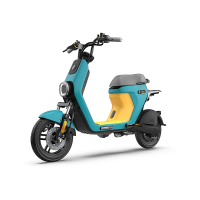
